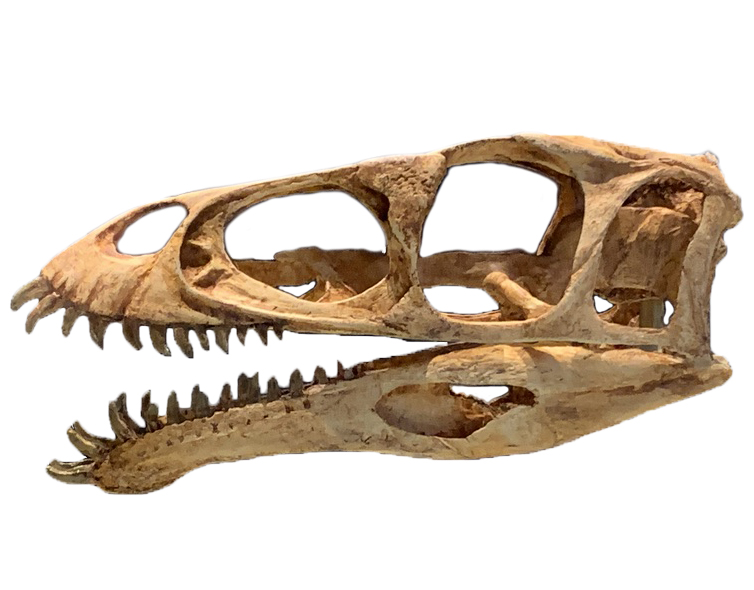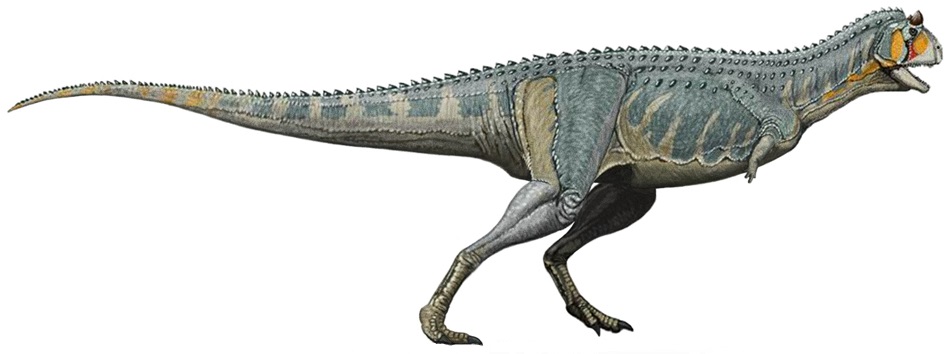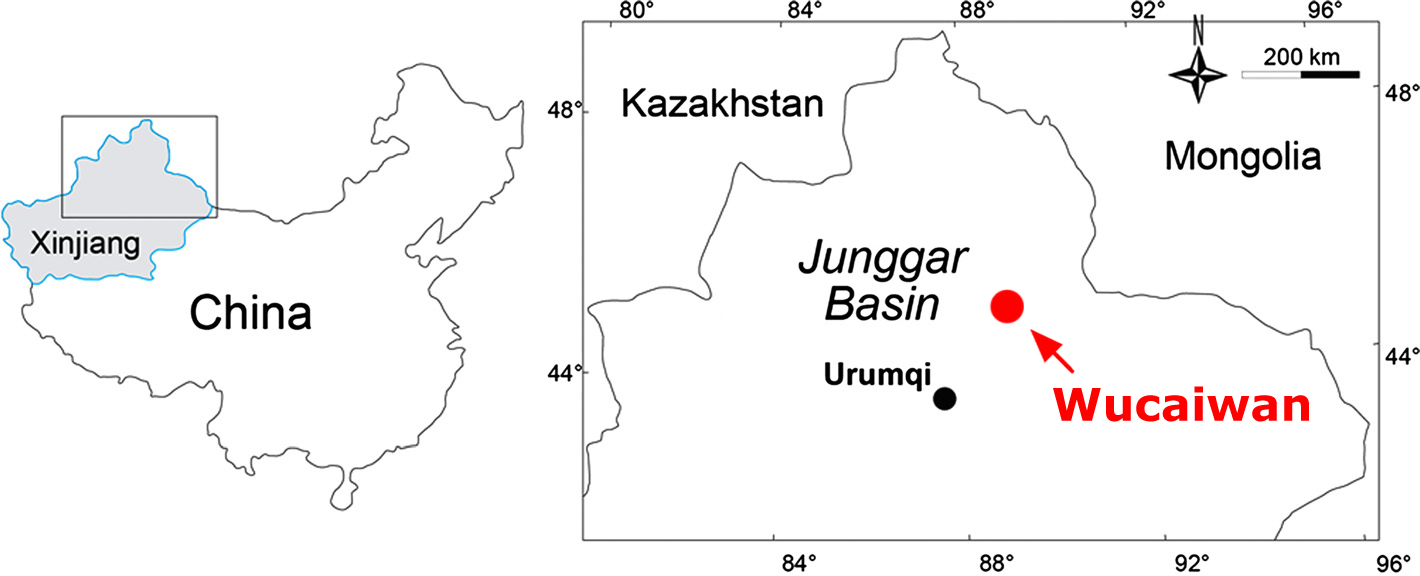|
Noasaurid
Noasauridae is an extinct family of theropod dinosaurs belonging to the group Ceratosauria. They were closely related to the short-armed abelisaurids, although most noasaurids had much more traditional body types generally similar to other theropods. Their heads, on the other hand, had unusual adaptations depending on the subfamily. 'Traditional' noasaurids, sometimes grouped in the subfamily Noasaurinae, had sharp teeth which splayed outwards from a downturned lower jaw. The most complete and well-known example of these kinds of noasaurids was '' Masiakasaurus knopfleri'' from Madagascar. Another group, Elaphrosaurinae, has also been placed within Noasauridae by some studies. Elaphrosaurines developed toothless jaws and herbivorous diets, at least as adults. The most complete and well known elaphrosaurine was '' Limusaurus inextricabilis''. At least some noasaurids had pneumatised cervical vertebrae.Arthur Souza Brum, Elaine Batista Machado, Diogenes de Almeida Campos & Ale ... [...More Info...] [...Related Items...] OR: [Wikipedia] [Google] [Baidu] |
Afromimus
''Afromimus'' (meaning "Africa mimic") is a genus of theropod dinosaur from the Early Cretaceous Elrhaz Formation of Niger. It contains a single species, ''A. tenerensis'', named in 2017 by Paul Sereno from parts of the right leg, vertebrae, and ribs found in the Ténéré Desert. It was originally classified as an ornithomimosaurian, but subsequently it was argued to be an abelisauroid. Discovery and naming The only known specimen of ''Afromimus'' is a partial skeleton consisting of seven (originating from the middle of the tail and estimated to be the 15th, 16th, 18th, 20th, 22nd, 24th, and 27th tail vertebrae), bones from the right hindlimb (the , , , and ), and part of a rib, all found within a radius of . It was discovered in 1997 at the Gadoufaoua locality in the Elrhaz Formation, in the Ténéré Desert of Niger. The specimen is catalogued as MNBH GAD112 in the Musée National Boubou Hama, the national museum of Niger in the city of Niamey. Since the specimen was expose ... [...More Info...] [...Related Items...] OR: [Wikipedia] [Google] [Baidu] |
Masiakasaurus Knopfleri
''Masiakasaurus'' is a genus of small predatory noasaurid theropod dinosaurs from the Late Cretaceous of Madagascar. In Malagasy, ''masiaka'' means "vicious"; thus, the genus name means "vicious lizard". The type species, ''Masiakasaurus knopfleri'', was named after the musician Mark Knopfler, whose music inspired the expedition crew. It was named in 2001 by Scott D. Sampson, Matthew Carrano, and Catherine A. Forster. Unlike most theropods, the front teeth of ''M. knopfleri'' projected forward instead of straight down. This unique dentition suggests that they had a specialized diet, perhaps including fish and other small prey. Other bones of the skeleton indicate that ''Masiakasaurus'' were bipedal, with much shorter forelimbs than hindlimbs. ''M. knopfleri'' was a small theropod, reaching long and weighing . ''Masiakasaurus'' lived around 70 million years ago, along with animals such as ''Majungasaurus'', ''Rapetosaurus'', and ''Rahonavis''. ''Masiakasaurus'' was a member ... [...More Info...] [...Related Items...] OR: [Wikipedia] [Google] [Baidu] |
Masiakasaurus Knopfleri Skull Reconstruction
''Masiakasaurus'' is a genus of small predatory noasaurid theropod dinosaurs from the Late Cretaceous of Madagascar. In Malagasy, ''masiaka'' means "vicious"; thus, the genus name means "vicious lizard". The type species, ''Masiakasaurus knopfleri'', was named after the musician Mark Knopfler, whose music inspired the expedition crew. It was named in 2001 by Scott D. Sampson, Matthew Carrano, and Catherine A. Forster. Unlike most theropods, the front teeth of ''M. knopfleri'' projected forward instead of straight down. This unique dentition suggests that they had a specialized diet, perhaps including fish and other small prey. Other bones of the skeleton indicate that ''Masiakasaurus'' were bipedal, with much shorter forelimbs than hindlimbs. ''M. knopfleri'' was a small theropod, reaching long and weighing . ''Masiakasaurus'' lived around 70 million years ago, along with animals such as ''Majungasaurus'', ''Rapetosaurus'', and ''Rahonavis''. ''Masiakasaurus'' was a member of ... [...More Info...] [...Related Items...] OR: [Wikipedia] [Google] [Baidu] |
Masiakasaurus
''Masiakasaurus'' is a genus of small predatory noasaurid theropod dinosaurs from the Late Cretaceous of Madagascar. In Malagasy, ''masiaka'' means "vicious"; thus, the genus name means "vicious lizard". The type species, ''Masiakasaurus knopfleri'', was named after the musician Mark Knopfler, whose music inspired the expedition crew. It was named in 2001 by Scott D. Sampson, Matthew Carrano, and Catherine A. Forster. Unlike most theropods, the front teeth of ''M. knopfleri'' projected forward instead of straight down. This unique dentition suggests that they had a specialized diet, perhaps including fish and other small prey. Other bones of the skeleton indicate that ''Masiakasaurus'' were bipedal, with much shorter forelimbs than hindlimbs. ''M. knopfleri'' was a small theropod, reaching long and weighing . ''Masiakasaurus'' lived around 70 million years ago, along with animals such as ''Majungasaurus'', ''Rapetosaurus'', and ''Rahonavis''. ''Masiakasaurus'' was a member o ... [...More Info...] [...Related Items...] OR: [Wikipedia] [Google] [Baidu] |
Noasaurus
''Noasaurus'' ("Northwestern Argentina lizard") is a genus of ceratosaurian theropod dinosaur genus from the late Campanian-Maastrichtian (Late Cretaceous) of Argentina. The type and only species is ''N. leali''. Discovery and naming In the mid-seventies, a fragmentary small theropod skeleton was discovered by Jaime Eduardo Powell and José Fernando Bonaparte at the Estancia El Brete-site. In 1977, the discovery was reported in the scientific literature. The type species, ''Noasaurus leali'', was named and described by Bonaparte and Powell in 1980. The generic name begins with a usual abbreviation of ''noroeste Argentina'', "northwest Argentina". The specific name honours the owner of the site, Fidel Leal.J. F. Bonaparte and J. E. Powell. 1980. "A continental assemblage of tetrapods from the Upper Cretaceous beds of El Brete, northwestern Argentina (Sauropoda-Coelurosauria-Carnosauria-Aves)". ''Mémoires de la Société Géologique de France, Nouvelle Série'' 139: 19-28 Th ... [...More Info...] [...Related Items...] OR: [Wikipedia] [Google] [Baidu] |
Berthasaura
''Berthasaura'' (meaning "Bertha's lizard") is a genus of noasaurid ceratosaurian theropod dinosaur from the Cretaceous Goio-Erê Formation of Paraná, Brazil. The type and only species is ''Berthasaura leopoldinae''. Discovery and naming Between 2011 and 2015, paleontologists working at the Cemitério dos Pterossauros site near Cruzeiro do Oeste discovered the skeletons of the pterosaurs ''Caiuajara'' and ''Keresdrakon'' as well as remains of small theropods. One of these was in 2019 named and described as ''Vespersaurus'' but a second species proved to be present. In 2021, the type species ''Berthasaura leopoldinae'' was named and described by Geovane Alves de Souza, Marina Bento Soares, Luiz Carlos Weinschütz, Everton Wilner, Ricardo Tadeu Lopes, Olga Maria Oliveira de Araújo and Alexander Wilhelm Armin Kellner. The generic name ''Berthasaura'' refers to the scientist and women's rights activist Bertha Maria Júlia Lutz, while the specific name honors Maria Leopoldina, ... [...More Info...] [...Related Items...] OR: [Wikipedia] [Google] [Baidu] |
Deltadromeus
''Deltadromeus'' (meaning "delta runner") is a genus of theropod dinosaur from Northern Africa. It had long, unusually slender hind limbs for its size, suggesting that it was a swift runner. The skull is not known. One fossil specimen of a single species (''D. agilis'', or "agile delta runner") has been described, found in the Kem Kem Beds, which date to the mid-Cretaceous Period (mid-Cenomanian age), about 95 million years ago. It may be a junior synonym of the contemporary ''Bahariasaurus''.Holtz, Thomas R. Jr. (2008) ''Dinosaurs: The Most Complete, Up-to-Date Encyclopedia for Dinosaur Lovers of All Ages'Supplementary Information/ref> The classification of ''Deltadromeus'' has been in flux since its original description. In 2016, a South American theropod known as ''Gualicho shinyae'' was found to possess many similarities with ''Deltadromeus''. Depending on the phylogenetic position of ''Gualicho'', ''Deltadromeus'' may have been a neovenatorid carnosaur, a tyrannosauroid, or ... [...More Info...] [...Related Items...] OR: [Wikipedia] [Google] [Baidu] |
Velocisaurus
''Velocisaurus'' ("swift lizard") is a genus of noasaurid theropod dinosaur from the Late Cretaceous period of Argentina. Description ''Velocisaurus'' was probably around long, based on a tibia length of . This makes it the smallest noasaurid, after ''Berthasaura''. The foot is unique in that the middle (third) metatarsal has become the main weight-bearing element. Its upper end has thickened whereas the shafts of the adjoining second and fourth metatarsals have thinned considerably. Such a configuration is unknown for other theropods, including birds. Bonaparte explained it as an adaptation for a cursorial (running) lifestyle. The high speed would have been necessary to escape larger theropods; Bonaparte suggested that ''Velocisaurus'' was itself an omnivore, as indicated by the fact that the sole claw found, of the fourth toe, was not trenchant but relatively straight. ''Velocisaurus'' can be characterized by several traits unknown in other Abelisauroids. These include: * ... [...More Info...] [...Related Items...] OR: [Wikipedia] [Google] [Baidu] |
Huinculsaurus
''Huinculsaurus'' (meaning "Huincul Formation lizard") is a genus of noasaurid dinosaur from the Huincul Formation in Neuquén Province, Argentina. The type and only species is ''Huinculsaurus montesi''. It was probably around when fully grown, although this is only speculation since no fully mature specimens are currently known. Discovery and naming ''Huinculsaurus'' is only known from three thoracic and two sacral vertebrae from an immature individual, discovered . It was discovered ten meters away from where the ''Ilokelesia'' holotype was discoveredCoria, R.A.; Salgado, L. & Calvo, J.O. (1991) "Primeros restos de dinosaurios Theropoda del Miembro Huincul, Formación Río Limay (Cretácico Tardío Presenoniano), Neuquén, Argentina." ''Ameghiniana'', 28: 405-406. and the vertebrae were mechanically separated during preparation. The genus was eventually named in 2020. Classification ''Huinculsaurus'' was placed in the Elaphrosaurinae subfamily of Noasauridae in 2020. It wa ... [...More Info...] [...Related Items...] OR: [Wikipedia] [Google] [Baidu] |
Vespersaurus
''Vespersaurus'' (meaning "western lizard") is a genus of noasaurid theropod dinosaur from the Late Cretaceous Rio Paraná Formation in the Paraná Basin, Brazil. The type and only species is ''V. paranaensis'', which would have lived in the giant prehistoric Botucatu Desert. Etymology The generic name is derived from the Latin "vesper," meaning "evening/west," in reference to the town Cruzeiro do Oeste ("Western Cross") near which the fossils were found, and the Greek "sauros," meaning "lizard." The specific name refers to the Paraná state. Discovery and naming After the discovery of numerous skeletons of the pterosaurs ''Caiuajara'' and ''Keresdrakon'' at the Cemitério dos Pterossauros site near Cruzeiro do Oeste, the remains of small theropods were uncovered between 2011 and 2015. One of these was named and described in 2019 as ''Vespersaurus''. The holotype, MPCO.V 0065d, was recovered from the Late Cretaceous period, found on dark red sandstones in the Rio Paran� ... [...More Info...] [...Related Items...] OR: [Wikipedia] [Google] [Baidu] |
Limusaurus
''Limusaurus'' is a genus of theropod dinosaur that lived in what is now China during the Late Jurassic, around 161 to 157 million years ago. The type and only species ''Limusaurus inextricabilis'' was described in 2009 from specimens found in the Upper Shishugou Formation in the Junggar Basin of China. The genus name consists of the Latin words for "mud" and "lizard", and the species name means "impossible to extricate", both referring to these specimens possibly dying after being mired. ''Limusaurus'' was a small, slender animal, about in length and in weight, which had a long neck and legs but very small forelimbs (with reduced first and fourth fingers). It underwent a drastic morphological transformation as it aged: while juveniles were toothed, these teeth were completely lost and replaced by a beak with age. Several of these features were convergently similar to the later ornithomimid theropods as well as the earlier non-dinosaurian shuvosaurids. ''Limusaurus ... [...More Info...] [...Related Items...] OR: [Wikipedia] [Google] [Baidu] |
Limusaurus Inextricabilis Skeleton
''Limusaurus'' is a genus of theropod dinosaur that lived in what is now China during the Late Jurassic, around 161 to 157 million years ago. The type and only species ''Limusaurus inextricabilis'' was described in 2009 from specimens found in the Upper Shishugou Formation in the Junggar Basin of China. The genus name consists of the Latin words for "mud" and "lizard", and the species name means "impossible to extricate", both referring to these specimens possibly dying after being mired. ''Limusaurus'' was a small, slender animal, about in length and in weight, which had a long neck and legs but very small forelimbs (with reduced first and fourth fingers). It underwent a drastic morphological transformation as it aged: while juveniles were toothed, these teeth were completely lost and replaced by a beak with age. Several of these features were convergently similar to the later ornithomimid theropods as well as the earlier non-dinosaurian shuvosaurids. ''Limusauru ... [...More Info...] [...Related Items...] OR: [Wikipedia] [Google] [Baidu] |









